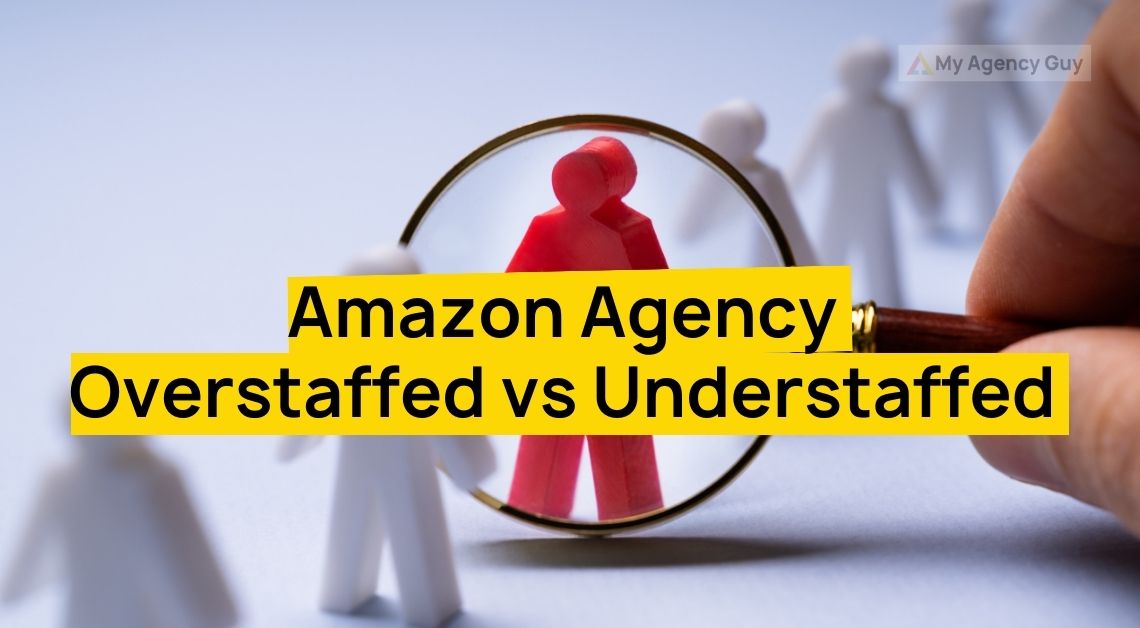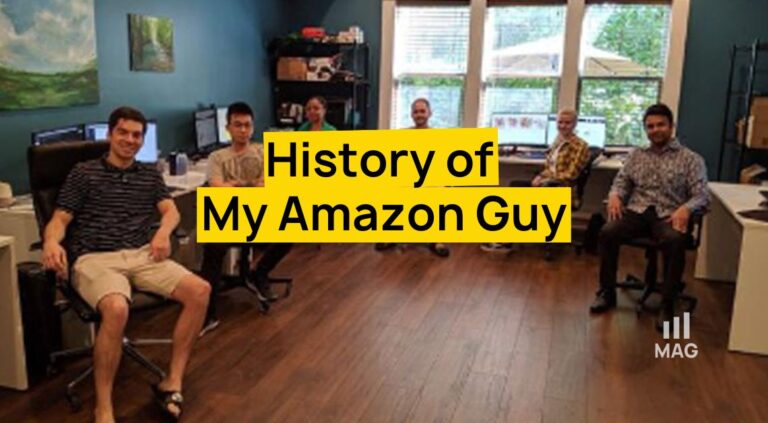Amazon Agency Challenges: Overstaffing vs Understaffing
A workforce in excess can lead to chaos, while a shortage might leave you stumbling. Finding the right rhythm is the key to success
Finding the right balance in the team is pivotal for the sustainable growth an Amazon agency. In this blog post, we’re diving deep into the strategies and insights that will help you strike the perfect equilibrium in the number of employees within your Amazon agency.
Nurturing a thriving Amazon agency demands more than just a team – it requires a harmonious blend of skill sets, strengths, and expertise.
Amazon Agency Staffing Affects Client Service and Relationships

For An Overstaffed Amazon Agency
While having a robust team is certainly advantageous, an overstaffed Amazon agency can face a surprising number of challenges when it comes to client service and relationships. Let’s dive into the key issues and explore potential solutions:
- Demotivation and Disengagement:
- A crowded agency environment can breed feelings of competition and lack of individual value. Employees may feel like cogs in a machine, leading to decreased motivation and engagement.
- Solution: Foster a collaborative culture with clear roles and responsibilities. Encourage open communication and celebrate individual achievements. Implement flexible work arrangements to combat feelings of confinement.
- Communication Bottlenecks:
- With too many cooks in the kitchen, decision-making can become sluggish and communication channels overloaded. Information can get lost in the shuffle, leading to confusion and frustration for both clients and employees.
- Solution: Establish clear communication channels and designate points of contact for each client. Utilize project management tools to streamline communication and ensure everyone is on the same page. Encourage concise and focused communication.
- Unfocused Client Attention:
- Spreading resources too thin can result in clients feeling neglected and overlooked. With less dedicated attention, their specific needs and concerns may not be adequately addressed.
- Solution: Implement client segmentation based on needs and prioritize workload accordingly. Allocate dedicated account managers or teams to ensure personalized attention and build stronger relationships.
- Increased Overhead Costs:
- A larger team translates to higher payroll, benefits, and equipment expenses. This can eat into profits and limit the agency’s ability to invest in resources or client services.
- Solution: Conduct regular cost-benefit analyses to identify areas for optimization. Utilize outsourcing or freelance talent for specific tasks. Implement performance-based incentives to encourage efficiency and productivity.
- Difficulty Scaling Up or Down:
- A bloated team may lack the agility to adapt to changing client needs or market trends. Scaling down during slow periods can be challenging, leading to layoffs and decreased morale.
- Solution: Prioritize cross-functional training and skill development to create a versatile team. Consider flexible employment models, such as part-time or contract work, to adjust staffing levels efficiently.
Understaffed Amazon Agency Woes
While an overstaffed agency faces its own set of challenges, running an understaffed Amazon agency can be equally, if not more, detrimental to client service and relationships. Let’s dissect the troubles of a lean team and explore potential solutions to get back on track:
- Burnout and Resentment:
- Imagine juggling multiple clients, deadlines, and tasks all while wearing every hat in the office. Employee burnout is inevitable, leading to decreased performance, high turnover, and resentment towards demanding clients.
- Solution: Prioritize workload distribution and clearly define roles and responsibilities. Encourage breaks and flexible work arrangements to combat fatigue. Implement performance reviews and recognize achievements to boost morale.
- Compromised Client Service:
- With limited resources, delivering exceptional client service becomes difficult. Clients may experience delayed responses, missed deadlines, and inadequate attention to their specific needs.
- Solution: Prioritize high-impact tasks and utilize automation tools to streamline processes. Set realistic expectations with clients and communicate potential delays transparently. Implement client segmentation and dedicate resources to high-value accounts.
- Missed Opportunities and Growth Stagnation:
- A stretched-thin team lacks the capacity to explore new growth opportunities or take on additional clients. This stagnation can lead to lost revenue and a competitive disadvantage.
- Solution: Outsource specific tasks like content creation or graphic design to free up internal resources. Collaborate with other agencies or freelancers on specific projects to expand capabilities. Consider strategic partnerships and mergers to access new talent and expertise.
- Difficulty Hiring and Retaining Talent:
- A chaotic, high-pressure environment with limited career growth prospects makes attracting and retaining top talent an uphill battle.
- Solution: Invest in employee training and development to create a learning culture and career growth opportunities. Foster a positive work environment with clear communication and employee appreciation. Offer competitive salaries and benefits to attract and retain talent.
- Erosion of Client Trust and Confidence:
- Inconsistent service, missed deadlines, and communication breakdowns can damage client trust and confidence. This can lead to client churn and negative word-of-mouth.
- Solution: Under-promise and over-deliver. Set realistic expectations and communicate potential challenges proactively. Track client satisfaction metrics and address concerns promptly. Invest in client relationship management tools to ensure seamless communication and personalized service.
Amazon Agency Staffing Affects Workflow and Operational Efficiency
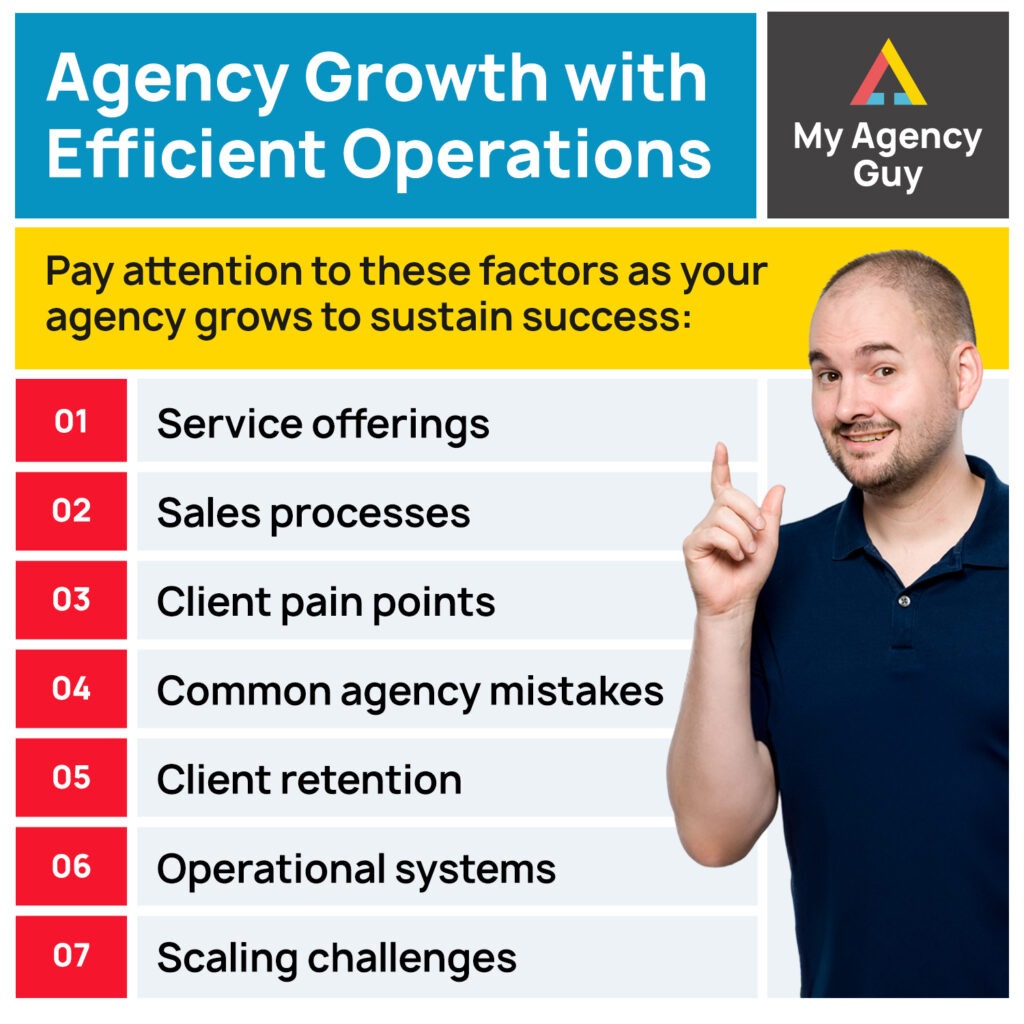
Overstaffing: A Double-Edged Sword for Workflow and Efficiency
For an Amazon agency with too many employees
- Redundancy and Bottlenecks:
- With overlapping roles and unclear task assignment, work gets duplicated, creating unnecessary bottlenecks. Decisions get lost in a sea of opinions, delaying progress and frustrating both employees and clients.
- Solution: Conduct a workflow review to identify redundancies and streamline processes. Implement clear roles and responsibilities with accountability matrices. Encourage open communication and collaboration to avoid decision paralysis.
- Increased Overhead and Reduced Scalability:
- A larger team translates to higher payroll, benefits, and equipment expenses. This can eat into profits and limit the agency’s ability to invest in resources or adapt to changes in the market.
- Solution: Analyze cost-benefit ratios and identify areas for optimization. Utilize outsourcing or freelance talent for specific tasks. Implement flexible employment models like part-time work or project-based contracts to adjust staffing levels efficiently.
- Dampened Morale and Decreased Engagement:
- Feeling like a cog in a crowded machine can be demotivating for employees. They may experience lack of ownership, leading to disengagement and decreased productivity.
- Solution: Foster a culture of collaboration and individual recognition. Encourage skill development and cross-functional training to create a versatile team. Implement performance-based incentives to boost engagement and ownership.
- Lack of Agility and Difficulty Adapting:
- A large, rigid team may struggle to adapt to fast-paced changes in the Amazon landscape. Decision-making processes can be slow, hindering the agency’s ability to seize new opportunities or respond to client needs effectively.
- Solution: Encourage flexible work arrangements and remote work options to promote agile thinking. Streamline communication channels and empower employees to make decisions within their scope. Invest in technology and automation tools to increase efficiency and adaptability.
- Blurred Communication and Lost Productivity:
- With too many voices in the room, communication can become chaotic and confusing. Information gets lost in the shuffle, leading to misunderstandings, duplicated efforts, and wasted time.
- Solution: Implement clear communication channels and project management tools. Designate points of contact for each client and ensure information transparency. Promote concise and focused communication to avoid misunderstandings.
Understaffed Amazon Agency
- Bottlenecks and Burnout:
- With everyone wearing multiple hats, tasks pile up, creating frustrating bottlenecks. Employees become overworked and burned out, leading to errors, decreased productivity, and high turnover.
- Solution: Prioritize high-impact tasks and implement project management tools to streamline workflow. Delegate effectively and encourage breaks to combat burnout. Invest in employee well-being programs to boost morale and retention.
- Missed Deadlines and Client Delays:
- Juggling too much can lead to missed deadlines and frustrated clients. This damages trust and reputation, impacting client retention and new business opportunities.
- Solution: Under-promise and over-deliver. Set realistic expectations with clients and communicate potential delays proactively. Utilize time management techniques and consider automation tools to optimize processes.
- Lack of Innovation and Growth Stagnation:
- With all hands on deck just keeping the lights on, there’s little time for exploring new opportunities or innovative solutions. Stagnation sets in, hindering growth and leaving the agency vulnerable to competition.
- Solution: Encourage cross-functional training and skill development to create a versatile team capable of tackling new challenges. Partner with other agencies or freelancers for specific projects to access additional expertise. Invest in technology and automation tools to free up human resources for innovation.
- Reactive Decisions and Inconsistent Quality:
- Lack of manpower can lead to rushed decisions and reactive firefighting, affecting the quality of service delivered. This inconsistency erodes client trust and creates a cycle of rework and inefficiency.
- Solution: Implement clear documentation and standardized processes to ensure consistency. Encourage data-driven decision making and invest in training to improve quality control measures.
- Difficulty Attracting and Retaining Talent:
- A chaotic, high-pressure environment with limited career growth prospects makes attracting and retaining top talent an uphill battle.
- Solution: Invest in employee training and development to create a learning culture and career growth opportunities. Foster a positive work environment with clear communication and employee appreciation. Offer competitive salaries and benefits to attract and retain talent.
Amazon Agency Staffing Affects Employee Engagement and Morale
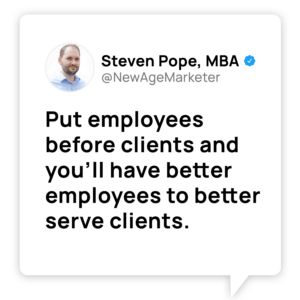
Overstaffing: A Dampener on Agency Spirit
- With overlapping roles and unclear responsibilities, employees feel like cogs in a machine, lacking a sense of ownership and purpose in their work. This leads to apathy and disengagement.
Solution: Conduct a workflow review to eliminate redundancy and clearly define roles with accountability. Encourage individual contribution and celebrate achievements to foster a sense of ownership. Create clear career paths and growth opportunities to give employees a purpose beyond day-to-day tasks.
- With too many voices in the room, decision-making becomes sluggish and communication channels overload. This leads to confusion, frustration, and a feeling of being out of the loop.
Solution: Implement clear communication channels and project management tools. Designate points of contact for each project and ensure information transparency. Promote concise and focused communication to avoid misunderstandings.
- A rigid, hierarchical structure with limited cross-training or skill development opportunities can feel confining and stifle employee growth. This leads to boredom, stagnation, and a desire to move on.
Solution: Encourage cross-functional training and skill development to create a versatile team. Offer mentorship programs and opportunities for leadership roles. Invest in employee training and development programs to show your commitment to their growth.
- Feeling like just another number can stifle creativity and innovative thinking. A homogenous team without diverse perspectives can lead to groupthink and missed opportunities.
Solution: Encourage brainstorming sessions and open communication, even from new or junior employees. Create a culture of experimentation and risk-taking, where trying new things is celebrated. Foster diversity of thought and background to bring fresh perspectives to the table.
- A disengaged and unmotivated workforce has high turnover rates, leading to recruitment headaches and a constant cycle of onboarding new employees.
Solution: Address the root causes of employee dissatisfaction and implement solutions to improve engagement and morale. Conduct regular employee satisfaction surveys and use the feedback to create a positive work environment. Offer competitive salaries, benefits, and perks to attract and retain top talent.
Understaffing Impact
- With everyone carrying a hefty workload, employees become prone to burnout, stress, and exhaustion. This negatively impacts engagement, leading to apathy, cynicism, and decreased productivity.
Solution: Prioritize tasks and delegate effectively. Ensure employees have reasonable workloads and encourage breaks to prevent burnout. Foster a culture of open communication and encourage employees to voice concerns or request assistance when feeling overwhelmed.
- Feeling like a cog in a machine with limited decision-making power can stifle employee engagement and motivation. This makes them feel replaceable and hinders their sense of ownership and purpose.
Solution: Empower employees by delegating tasks and providing opportunities for independent decision-making. Encourage ownership of projects and celebrate successes to make them feel valued and integral to the agency’s success.
- A stagnant environment with limited training or career advancement prospects can make employees feel stuck and uninspired. This leads to boredom, frustration, and a desire to move on for better opportunities.
Solution: Invest in employee training and development to foster a culture of continuous learning and upskilling. Provide clear career paths with opportunities for growth and advancement. Encourage feedback and mentorship to support individual development goals.
- Feeling out of the loop and lacking clear communication about agency goals and decisions can make employees feel disconnected and undervalued. This builds resentment and disengagement.
Solution: Enhance communication channels and ensure regular updates and transparency about agency goals, challenges, and successes. Encourage open dialogue and two-way communication to address concerns and foster a sense of belonging.
- A disengaged and unmotivated workforce with limited growth prospects has high turnover rates, leading to recruitment headaches and a constant cycle of onboarding new employees. This affects team cohesion and hampers overall agency performance.
Solution: Address the root causes of employee dissatisfaction and implement solutions to improve engagement and morale. Conduct regular employee satisfaction surveys and use the feedback to create a positive work environment. Offer competitive salaries, benefits
Amazon Agency Staffing Affects Cost Management and Profitability

Overstaffing: A Drain on Profits and Potential
- Every additional employee brings additional salary, benefits, and equipment costs. This eats into profits, leaving less room for reinvestment, client discounts, or competitive salaries to attract top talent.
Solution: Conduct regular cost-benefit analyses to identify unnecessary expenses. Optimize team size based on workload and client needs. Consider flexible employment models like part-time work or project-based contracts to adjust staffing levels efficiently.
- A large, rigid team can be slow to adapt to market changes or client demands. This inflexibility can lead to missed opportunities, delayed responses, and ultimately, lost revenue.
Solution: Encourage cross-functional training and skill development to create a versatile team. Streamline decision-making processes and empower lower-level employees to make decisions within their scope. Invest in technology and automation tools to increase efficiency and adaptability.
- Feeling like a cog in a crowded machine can be demotivating for employees. They may experience boredom, lack of ownership, and decreased productivity, leading to higher operating costs.
Solution: Foster a culture of collaboration and individual recognition. Encourage skill development and career growth opportunities. Implement performance-based incentives to boost engagement and ownership.
- With too many employees, it becomes difficult to track individual contributions and measure the ROI of specific roles. This makes it hard to identify cost-saving opportunities and optimize resource allocation.
Solution: Implement clear performance metrics and establish accountability matrices for every role. Utilize project management tools to track individual contributions and team efficiency. Regularly review employee performance and adjust roles or positions as needed.
- Resources swallowed by excessive overhead leave less room for investing in technology, marketing, or client-centric initiatives. This can hinder growth and make the agency less competitive.
Solution: Analyze cost-benefit ratios and identify areas for resource reallocation. Invest in tools and automation that can free up human resources for higher-value activities. Prioritize strategic partnerships or outsourcing specific tasks to optimize internal spending.
Understaffing: A False Economy for Profitability
- Lost Revenue and Client Churn:
- With limited manpower, it’s difficult to take on new clients or handle existing accounts effectively. Missed deadlines, slow responses, and inconsistent service can lead to client churn and lost revenue.
- Solution: Prioritize high-value clients and delegate effectively. Utilize outsourcing or freelance talent for specific tasks to expand capacity without permanent overhead. Focus on client retention strategies and invest in communication tools to ensure consistent service.
- Inefficiency and Wasted Resources:
- Overworked employees become prone to errors and rework, wasting valuable time and resources. Lack of automation and standardized processes further contributes to inefficiency.
- Solution: Invest in project management tools and automation to streamline processes and prevent rework. Implement clear documentation and standardized procedures to ensure consistency and efficiency. Encourage data-driven decision making and continuous improvement initiatives.
- Missed Growth Opportunities:
- With all hands on deck just keeping the lights on, there’s little time for exploring new markets, services, or partnerships. This stagnation limits growth potential and makes the agency vulnerable to competition.
- Solution: Encourage cross-functional training and skill development to create a versatile team capable of tackling new challenges. Partner with other agencies or freelancers for specific projects to access additional expertise. Invest in technology and automation tools to free up human resources for innovation and growth initiatives.
- Low Employee Morale and Productivity:
- A high-pressure environment with limited support can lead to burnout, decreased morale, and higher turnover. This negatively impacts productivity and client relationships.
- Solution: Invest in employee well-being programs and encourage work-life balance. Implement flexible work arrangements to reduce stress and boost morale. Offer competitive salaries and benefits to attract and retain talent.
- Difficulty Attracting and Retaining High-Caliber Talent:
- A chaotic, high-workload environment with limited career growth prospects makes attracting and retaining top talent an uphill battle. This can further hinder profitability and growth.
- Solution: Invest in employee training and development to create a learning culture and career growth opportunities. Foster a positive work environment with clear communication and employee appreciation. Offer competitive salaries and benefits to attract and retain talent.
Amazon Agency Staffing Affects Technology and Automation Adoption
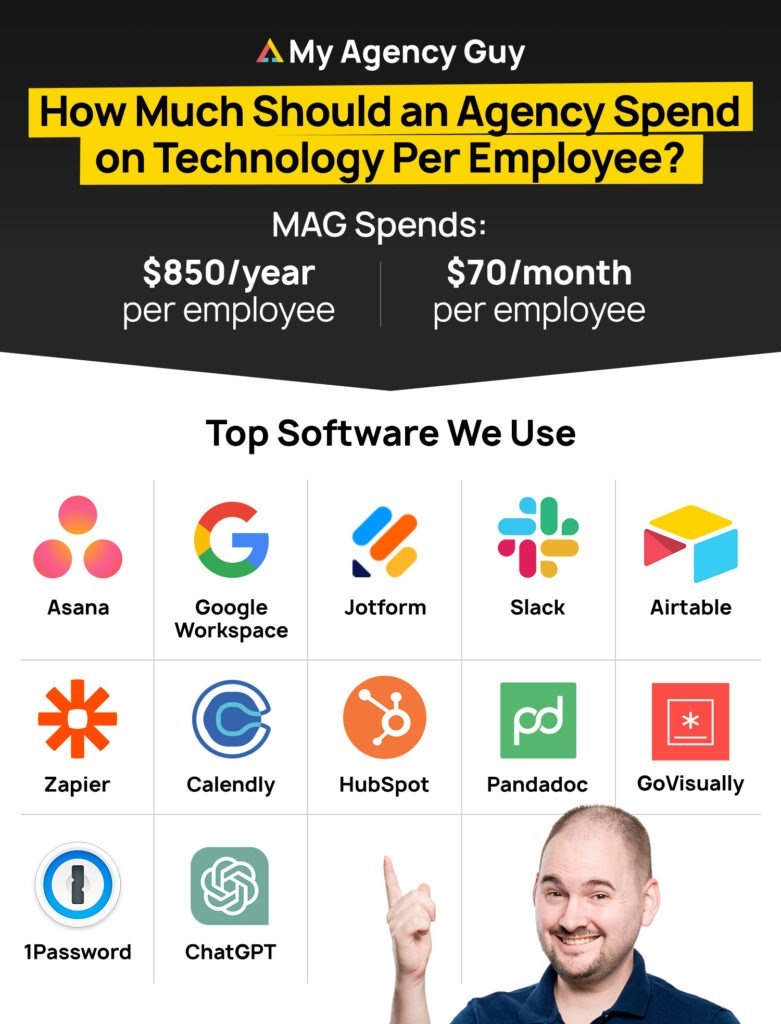
Overstaffing: A Damper on the Tech Revolution
- Resistance to Change and Fear of Job Loss:
- With established routines and comfort in familiar tools, some employees may view automation as a threat to their job security. This resistance can stifle the introduction of new technologies and slow down progress.
- Solution: Foster a culture of continuous learning and upskilling. Clearly communicate the benefits of automation, emphasizing how it frees up employees for higher-value tasks and enhances their skillset. Implement pilot programs and involve teams in the selection and training process to build buy-in.
- Lack of Resources and Time for Implementation:
- Overworked employees and a stretched-thin budget can leave little room for exploring new tools or dedicating time to implementation. This creates a vicious cycle where lack of automation further amplifies workload pressures.
- Solution: Prioritize tasks and leverage existing resources effectively. Allocate dedicated time for team members to learn and test new technologies. Consider temporary outsourcing or hiring specialists for the implementation phase.
- Inefficient Workflow and Data Silos:
- A messy workflow with poor data organization can make it difficult to automate processes effectively. Silos between teams and departments further hinder the seamless integration of technology.
- Solution: Conduct a process review and streamline workflows before attempting automation. Implement data governance and standardization practices to ensure clean and accessible information. Break down departmental silos and encourage cross-functional collaboration.
- Inconsistent Training and Knowledge Gaps:
- Without proper training and support, employees may struggle to adapt to new tools. Inconsistent knowledge within the team can lead to errors and inefficiencies, negating the benefits of automation.
- Solution: Develop comprehensive training programs that cater to different learning styles and levels. Offer ongoing support and access to resources to help employees master new technologies. Encourage peer-to-peer knowledge sharing and collaboration.
- Difficulty Measuring ROI and Justifying Costs:
- With limited resources and competing priorities, justifying the investment in new technologies can be challenging. Lack of clarity around ROI can further discourage agency owners from embracing automation.
- Solution: Conduct cost-benefit analyses and clearly define performance metrics before implementation. Track the impact of automation on efficiency, productivity, and cost savings to quantify the ROI. Share success stories and tangible benefits with the team to build enthusiasm.
Understaffing: A Stumbling Block on the Tech Trail
- Lack of Time and Bandwidth for Research and Implementation:
- With everyone already running on fumes, researching, selecting, and implementing new technologies take a backseat. This can lead to missed opportunities and falling behind competitors who embrace automation.
- Solution: Prioritize tasks and set aside dedicated time for tech exploration. Encourage employees to contribute ideas and participate in pilot programs. Consider outsourcing specific research or implementation tasks to free up internal resources.
- Limited Expertise and Skill Gaps:
- A small team may lack the necessary expertise to choose, configure, and manage complex automation tools. This can lead to failed implementations, wasted resources, and frustration.
- Solution: Invest in employee training and skill development to build internal expertise in automation technologies. Partner with consultants or technology providers for support and training during the implementation phase. Encourage cross-functional learning and knowledge sharing within the team.
- Reactive Decisions and Inability to Adapt:
- With limited resources, agencies often focus on firefighting daily tasks, leaving little room for proactive strategy and adaptation. This can hinder the ability to leverage technology for long-term efficiency and growth.
- Solution: Encourage data-driven decision making and invest in analytics tools to gain insights into workflow bottlenecks and opportunities for automation. Develop a strategic roadmap for technology adoption and allocate resources accordingly.
- Difficulty Justifying Costs and Measuring ROI:
- With tight budgets and a focus on immediate needs, justifying the upfront costs of technology and automation can be challenging. Lack of data on potential return on investment further discourages implementation.
- Solution: Conduct cost-benefit analyses and identify tasks where automation can deliver the most significant impact. Track key metrics before and after implementation to showcase the benefits of technology, such as increased efficiency, cost savings, and improved client service. Share success stories and tangible results to build internal buy-in for future investments.
- Overreliance on Manual Processes and Individual Skillsets:
- A stretched-thin team often relies heavily on individual skillsets and manual processes, making them vulnerable to employee turnover and knowledge gaps. This lack of automation creates a fragile foundation for growth and sustainability.
- Solution: Standardize and document processes to create a system that relies less on individual knowledge and is easier to train others on. Identify repetitive tasks that can be automated and prioritize their implementation. Invest in tools and systems that can capture and share key operational data, reducing dependence on individual memory or expertise.
Amazon Agency Staffing Affects Scalability and Growth Potential

Impact of Overstaffing On Scalability and Growth Potential
- Increased Overhead and Reduced Agility:
- A larger team translates to higher payroll, benefits, and equipment expenses. This eats into resources that could be invested in growth initiatives or adapting to market changes.
- Solution: Analyze cost-benefit ratios and identify areas for optimization. Utilize flexible employment models like part-time work or project-based contracts to adjust staffing levels efficiently. Invest in technology and automation to free up human resources for higher-value tasks.
- Difficulty Adapting to Market Changes and Client Needs:
- A large, rigid team can be slow to adapt to new trends, competitor moves, or evolving client demands. This lack of agility can lead to missed opportunities and lost market share.
- Solution: Encourage cross-functional training and skill development to create a versatile team. Streamline decision-making processes and empower lower-level employees to make decisions within their scope. Invest in technology and automation tools to increase efficiency and adaptability.
- Dampened Innovation and Risk-Taking:
- With established routines and a focus on maintaining the status quo, an overstaffed agency may discourage new ideas and innovative approaches. This can stunt growth and make your agency vulnerable to disruption.
- Solution: Foster a culture of experimentation and risk-taking. Celebrate successful innovations and encourage employees to share ideas. Implement processes for evaluating and adopting new technologies or strategies.
- Decision Paralysis and Slowed Progress:
- With too many voices in the room, decision-making can become sluggish and bogged down by unnecessary layers of approval. This delays progress and creates frustration for both employees and clients.
- Solution: Clearly define roles and responsibilities with accountability matrices. Streamline communication channels and designate points of contact for each project. Promote concise and focused communication to avoid misunderstandings and delays.
- Difficulty Attracting and Retaining Top Talent:
- A crowded, high-pressure environment with limited growth opportunities can make attracting and retaining top talent an uphill battle. This talent drain further hinders growth potential.
- Solution: Invest in employee training and development to create a learning culture and career growth opportunities. Foster a positive work environment with clear communication and employee appreciation. Offer competitive salaries and benefits to attract and retain talent.
Impact of Understaffing On Scalability and Growth Potential
- Bottlenecks and Missed Opportunities:
- Overworked employees become prone to errors and rework, wasting valuable time and hindering progress. Lack of manpower can lead to missed deadlines, client churn, and lost opportunities for expansion.
- Solution: Prioritize high-value tasks and delegate effectively. Utilize outsourcing or freelance talent for specific tasks to increase capacity without permanent overhead. Focus on client retention strategies and invest in communication tools to ensure consistent service.
- Limited Capacity and Inability to Handle New Clients:
- With a stretched-thin team, taking on new clients or expanding services becomes difficult. This restricts revenue streams and limits growth potential.
- Solution: Encourage cross-functional training and skill development to create a versatile team capable of handling diverse tasks. Consider strategic partnerships or mergers to access additional expertise and resources. Invest in automation tools to free up human resources for client acquisition and onboarding.
- Lack of Innovation and Stagnation:
- With all hands on deck just keeping the lights on, there’s little time for exploring new markets, services, or partnerships. This stagnation limits growth potential and makes the agency vulnerable to competition.
- Solution: Encourage brainstorming sessions and open communication, even from new or junior employees. Create a culture of experimentation and risk-taking, where trying new things is celebrated. Partner with other agencies or freelancers for specific projects to access fresh perspectives and expertise.
- High Turnover and Recruitment Challenges:
- A chaotic, high-workload environment with limited career growth prospects can lead to high turnover rates and difficulty attracting top talent. This further hinders growth and stability.
- Solution: Address the root causes of employee dissatisfaction and implement solutions to improve engagement and morale. Conduct regular employee satisfaction surveys and use the feedback to create a positive work environment. Offer competitive salaries, benefits, and perks to attract and retain talent.
- Difficulty Measuring Progress and ROI:
- With limited resources and competing priorities, measuring the impact of growth initiatives can be challenging. Lack of clarity around ROI can discourage further investment in expansion.
- Solution: Define clear key performance indicators (KPIs) aligned with your growth goals. Implement data analytics tools to track progress and measure the effectiveness of your strategies. Share success stories and tangible results to build internal buy-in for future investments.
Amazon Agency Staffing Affects Training and Development

Overstaffing Impacts
- Lack of Clear Roles and Scattered Knowledge:
- With overlapping roles and unclear responsibilities, employees may not understand their specific training needs or benefit from targeted sessions. Knowledge gets diluted across the team, creating gaps and inefficiencies.
- Solution: Conduct a workflow review and clearly define roles with accountability matrices. Identify individual training needs based on assigned responsibilities and career goals. Implement mentorship programs to facilitate knowledge sharing and guidance within the team.
- Limited Opportunities for Hands-on Experience:
- A crowded team can lead to competition for projects and learning opportunities. Some employees may become stuck in repetitive tasks, lacking the chance to apply new skills or gain practical experience.
- Solution: Rotate project assignments strategically to ensure everyone gets exposure to diverse tasks and challenges. Foster a collaborative environment where employees can learn from each other through pair programming, knowledge sharing initiatives, and team-based projects.
- Difficulty Measuring Training Effectiveness:
- With a large team and diverse learning needs, tracking the impact of training programs can be difficult. Lack of clear metrics and evaluation methods hinders adjustments and improvement.
- Solution: Define clear learning objectives and develop pre- and post-training assessments to measure effectiveness. Encourage active participation and feedback during training sessions to identify areas for improvement. Gather data on skill utilization and project performance post-training to assess its practical impact.
- Demotivation and Disengagement:
- Feeling like a cog in a machine can dampen employee motivation to actively seek out training or upskilling. This disengagement hinders personal growth and overall team progress.
- Solution: Foster a culture of continuous learning and encourage employees to take ownership of their development. Offer personalized training plans aligned with individual goals and interests. Recognize and reward participation in training initiatives to boost engagement.
- Increased Costs and Resource Strain:
- Providing training for a large team translates to higher costs for materials, instructors, and time investment. This can strain resources and limit the variety or frequency of training programs offered.
- Solution: Explore cost-effective training options like online courses, peer-to-peer learning, or internal talent development programs. Utilize open-source resources and technology tools to facilitate knowledge sharing and learning within the team.
Understaffing Impact
- With everyone already wearing multiple hats, finding time for dedicated training sessions or employee development initiatives becomes a luxury. This can lead to knowledge gaps and hinder skill development.
Solution: Prioritize learning and development as a core aspect of the agency’s culture. Dedicate specific time slots in the workweek for self-directed learning or team-based upskilling sessions. Explore micro-learning resources like short online courses or bite-sized training modules accessible during downtime.
- A stretched-thin team may lack senior employees or dedicated mentors to provide guidance and support for skill development. This can leave junior employees feeling lost and uncertain about their growth path.
Solution: Encourage peer-to-peer learning and knowledge sharing within the team. Implement a buddy system where experienced employees mentor newer team members. Utilize external mentors or online coaching services to supplement internal guidance.
- With the focus on keeping up with daily tasks, agencies often neglect proactive training needs assessments or miss opportunities for upskilling based on market trends. This can hinder long-term skill development and adaptability.
Solution: Conduct regular skills assessments to identify individual and team learning needs. Stay updated on industry trends and emerging technologies, incorporating relevant training modules into your development programs. Encourage employees to propose new learning initiatives based on their interests and goals.
4.Image: In a high-pressure environment, employees may prioritize finishing tasks over attending training sessions, perceiving them as a burden or time drain. This can lead to lower engagement and limited learning outcomes.
Solution: Align training with clear career progression opportunities and incentivize participation through bonus structures, skill-based promotions, or recognition programs. Make training engaging and interactive, applying new skills to real-world projects to showcase their value.
- Tight budgets in understaffed agencies may restrict investment in comprehensive training programs, software tools, or external resources. This can limit the variety and quality of learning opportunities available.
Solution: Explore cost-effective training options like online courses, open-source resources, or industry meetups. Leverage team expertise and encourage internal knowledge sharing through presentations, brown-bag lunches, or hackathons. Partner with other agencies or educational institutions for collaborative training initiatives or resource sharing.
Why Is It Challenging For An Amazon Agency To Avoid Being Overstaffed Or Understaffed?
Navigating staffing levels in an Amazon agency is challenging due to the dynamic e-commerce industry:
Seasonal Fluctuations: Peak seasons or events can spike client demand, necessitating extra staff. Predicting and adjusting to these fluctuations is challenging.
Client Portfolio Variability: Client needs change unexpectedly. New clients may require more resources, while others reduce services, making consistent staffing challenging.
Industry Trends and Algorithm Changes: Frequent changes in e-commerce landscape require agencies to adapt. New strategies or technologies may lead to potential overstaffing.
Client Expectations and Service Demands: Diverse and evolving expectations of Amazon sellers result in variations in service demands, challenging consistent staffing.
Uncertainty in Business Growth: The uncertain growth trajectory of an agency makes aligning staffing levels challenging, contributing to overstaffing or understaffing.
Competitive Pressures: The competitive nature compels agencies to scale rapidly, potentially leading to overstaffing if not aligned with actual demand.
Client Retention and Acquisition: Strategic efforts for client retention or acquisition may necessitate staffing adjustments, impacting the potential for understaffing.
Client-Specific Requirements: Unique client requirements may demand additional staff. Balancing diverse client needs with consistent staffing is challenging.
Dynamic Nature of Amazon’s Platform: Amazon’s evolving platform requires quick adaptation, potentially affecting staffing needs.
Economic Factors: Economic conditions influencing consumer behavior create uncertainty in the demand for Amazon agency services, impacting staffing requirements.
Conclusion
Finding the sweet spot for your Amazon agency is an ongoing experiment. Don’t be afraid to adjust, tinker, and test. Listen to your gut, track your metrics, and remember, a happy, productive team is always better than a bloated, expensive one.
